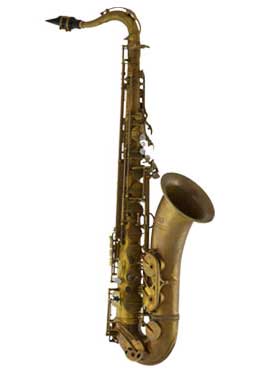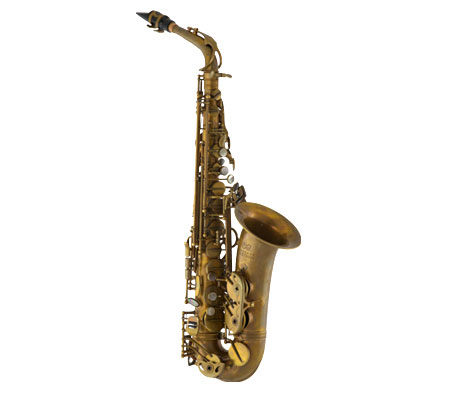Putting the New Eastman 52nd Street Alto and Tenor Saxes to the Test
 After demoing the Eastman 52nd Street tenor saxophone at the 2013 NAMM show, I knew I had to take a second look at this horn to see how it compared some of the other tenor saxophones I tried out at the NAMM show, along with my Mark VI.
After demoing the Eastman 52nd Street tenor saxophone at the 2013 NAMM show, I knew I had to take a second look at this horn to see how it compared some of the other tenor saxophones I tried out at the NAMM show, along with my Mark VI.
Ralph Torres, saxophone product specialist at Andreas Eastman, was nice enough to send me the 52nd Street tenor as well as the 52nd Street alto. Ralph said if I enjoyed the 52nd Street tenor, I would like the alto just as much. I am going to be reviewing both saxophones on their:
- Appearance
- Build Quality
- Tone and Response
- Action
- Intonation
Tenor
 Appearance
Appearance
The 52nd Street tenor has the aged brass finish which gives it a vintage look as if the horn had been aged over a period of time. The finish on this horn reminds me more of a un-lacquered cognac finish than the matte gold lacquer finish which other manufacturers finish their horns to give them a “vintage” look. The black mother of pearl key touches makes the horn visually pop and nicely compliments the aged brass look.
One of the most unique characteristics on this tenor is its engraving. The 52nd Street scene engraving is completely different from the typical floral engravings and is the first modern saxophone I have seen with a unique engraving.
Build Quality
The Eastman 52nd Street tenor saxophone was built to last. The tenor is heavier than my Mark VI as well as my Yanagisawa 991 tenor. This can be attributed to its oversized bell as well as double arms on the B, Bb and low C keys. I did notice some blemishes from soldering work throughout the saxophone, but for the most part, all of it was well removed around each key.
The pads laid correctly on the rolled-style tone holes. I do not believe these are true rolled tone holes and they might be soldered on. One feature that I have never seen on a Taiwanese saxophone was the adjustable palm keys. I have only seen adjustable palm keys on the professional model Keilwerth saxophones up until now. These Palm keys can be adjusted further out on the D, E, and F spatula keys. This saxophone comes with a small allen wrench so you can adjust the palm keys to your preference. Some additional screws are also included in case you lose one while adjusting a palm key.
I could tell that this saxophone had been play-tested to check for any major leaks as well as any manufacturing issues because there were no major issues I could see with the construction and much of the blemishes and soldering could have appeared because of the aged finishing.
Tone & Response
The Eastman 52nd Street tenor saxophone was incredibly responsive. From low Bb to high F# and up into the altissimo register with very little effort. I would say this tenor had an enormous sound that was much more spread than focused. The tone was on the edgier side and the lower and upper register had a vibrant sound. I did find the mid register to be a bit neutral and found more resistance in this register than anywhere else on the horn.
Action
I felt the action on the 52nd Street tenor was open rather than the keys sitting close to the tone holes. I found the low Bb to be a bit too easy to push down and would have had the spring tension tighter on this key, because when playing the low Bb I felt the key went down a little too far. In addition, I would like the G# pearl to be a bit wider because when I adjusted the palm keys I felt that my pinky felt most comfortable at the edge of the pearl. The overall action on this horn was very tight and if you prefer a looser spring tension, your repairman could take care of this for you. Besides a few small things that I would have adjusted to this tenor, I would say the action felt comfortable under the fingers and the horn was easy to maneuver around.
Intonation
I found the overtones were easier to produce on the 52nd Street tenor saxophone compared to my Mark VI. I did find myself a little bit sharp at first in the upper and lower register but once I adjusted and played this tenor over the next couple of weeks I found the intonation to play evenly throughout the horn. I still found my Mark VI to feel a bit more stable while moving through my overtone exercises, but this could be because I was not used to the ease with which my overtones came out on the 52nd Street saxophone.
Overall
I would say the 52nd Street tenor is another saxophone competing with horn manufacturers to offer the player all the characteristics of a great vintage sound and look, but with modern key-work. Overall, I liked the 52nd Street saxophone in terms of the overall tone, key-work, and build quality and would recommend this tenor to players looking for a pro horn.
Alto
 Appearance
Appearance
Like the 52nd street tenor saxophone, the 52nd Street alto saxophone has the aged brass finish, which gives it a vintage look as if the horn has aged over a period of time.
Build Quality
Like the 52nd street tenor saxophone, the Eastman 52nd Street alto saxophone was built to last. The alto was heavier than my Selmer Super Balanced Action alto and my Yamaha Custom 875. This can be attributed to its oversized bell as well as double arms on the B, Bb and low C key. I did notice some soldering work throughout the saxophone and most of it was well removed around each key.
As for the tone holes and palm keys, just like I mentioned for the tenor, the rolled-style tone holes as well as pads laid correctly on the tone-holes and seem like they might be soldered on.The palm keys were also adjustable. Also like the tenor, the horn comes with an allen wrench and additional screws for the palm key adjustment.
Tone & Response
The responsiveness on the alto was similar to the tenor. The sound on the alto had the edgy characteristics of the tenor, and I found the horn to play bright throughout the range of the instrument. I believe the metal resonators with this aged brass finish made the alto bright and loud. This horn had a very big and spread sound like the tenor, but with the right mouthpiece you could have a nice core sound.
Action
The action and my corrections on the tenor are the same on the 52nd street alto except for two things. I found the height of the G Pearl to be at the same height or a bit higher than the A which felt a bit uncomfortable while playing throughout the rest of the horn. Luckily, this is a very simple fix and can be adjusted to your preference. The 2nd exception was I found the oversized bell to lay very close to the G#, C#, B, and Bb keys. I would suggest that the bell be a little bit further out from those keys or those keys be moved back a little bit.
Intonation
I found the overtones were as easy to produce on the 52nd street alto saxophone as it is on my Selmer Super Balanced Action Alto. I did find myself a little bit sharp at first in the upper register, but once I adjusted and played this alto over the next couple of weeks, I found the intonation to play even throughout the horn.
Overall
I found the 52nd Street alto to be responsive, comfortable under the fingers, and to produce a very big sound that would work great in a big band or saxophone quartet.
Sound Clips
These sound clips show me A/B-ing the Eastman horns with the horns I normally play on.
Tenor
- 52nd Street, Slant Otto Link hard rubber mouthpiece (7), Vandoren M/O ligature, Alexander Superial 3 reed.
[audio: STE-017.mp3] - Selmer Mark VI, Slant Otto Link hard rubber mouthpiece (7), Vandoren M/O ligature, Alexander Superial 3 reed.
[audio: STE-022.mp3]
Alto
- 52nd Street, Meyer hard rubber mouthpiece (6), Rovner Eddie Daniels Edition Ligature, Alexander Superial 3 reed.
[audio: STE-0011.mp3] - Selmer Super Balanced Action, Meyer hard rubber mouthpiece (6), Rovner Eddie Daniels Edition Ligature, Alexander Superial 3 reed.
[audio: SBA-000.mp3]
Final Thoughts
My overall thoughts about the 52nd Street tenor and 52nd Street alto saxophones are these are two horns that have a lot to offer. I would say if you are considering buying a new tenor or alto saxophone and are looking for a sound that is edgy, full, and would work playing contemporary music, I would give the 52nd Street tenor and alto saxophones a try.
I believe there are some minor improvements that can be made to both these saxophones in regards to the action but that is with all saxophones.
I would like to thank Ralph Torres for sending me the 52nd Street tenor and alto saxophone and am glad I can count the 52nd Street saxophone as another horn on my list when I am ready to purchase my next sax.
To see more pictures and learn more about the Eastman Music Company (a company that produces many types of instruments, not just wind), click here.






July 25, 2013 @ 8:09 am
I tried some Eastman prototypes a couple of years ago. From your review, it seems that maybe they have made some improvements since then.
One thing that struck me as add about them was that they used a lot of hex/Allen screws instead of the usual slotted screws (I don’t recall the ones I played having the adjustable palm keys). The Eastman rep I spoke with had no explanation for this. Did the ones you played have hex screws, besides the palm keys?
July 25, 2013 @ 9:46 am
Hey Bret,
To be honest I only believe the palm keys had the hex screws but I do believe you could adjust other parts of tenor and alto and they might also have hex screws.
I know alot of horns come with slotted screws as you mentioned.
What is your current setup?
Zach
July 25, 2013 @ 12:01 pm
I actually like the sound of the 52 tenor better than the MK VI. On the alto, I wasn’t so sure. Thought you were very comfortable with the Mk VI alto.
July 30, 2013 @ 6:31 pm
Hey Andrew,
I am used to playing my Selmer Mark VI tenor but thought the 52nd street tenor played great.
On alto, I felt more comfortable on my SBA than the 52nd street alto but I did like some the features on the 52nd street alto that I wish my SBA had.
June 10, 2014 @ 7:50 pm
I recently tried a Eastman 52nd Street alto. Love the sound, but I agree about the location and feel of the keys. Just didn’t seem as comfortable ergonomically as some other saxophones I played. I had the local repairman adjust the G# key. Too much play in it and it felt a bit “spongy” too me. Also, I wasn’t happy with the placement of the low B and C# keys. I had the heights adjusted so the rollers could work more effectively. Speaking of rollers, I noticed they seem small compared to some other horns I played. Not sure if this matters or not, just thought I’d mention it. Anyhow, the adjustments of the keys were enough to make me reconsider buying this horn. I really like the Yamahas and the Cannonball Big Bell Series, but for the price (I’m a doubler, so don’t want to pay a fortune) I can’t find a better horn. The local dealer is selling off his instruments due to just concentrating on repairs, so I don’t think I can pass this deal up.
July 25, 2020 @ 7:22 am
Has anyhone compared the new edition 52nd Street tenor (made in China) to the earlier 52nd street tenor from Taiwan?
Thoughts please.
July 25, 2020 @ 3:10 pm
Hey Gary,
At NAMM 2020, I was able to play test the new Eastman 52nd street tenor which showcased the new keywork https://www.bestsaxophonewebsiteever.com/namm-2020-saxophone-gear-roundup/. I personally much more preferred the new key work and am excited to see Eastman taking the Keywork from the 850 model and putting it on the Eastman 52nd street tenor (this is the keywork with the flute like key touches and some additional modifications). Since the 850 model also had two necks available at the 2020 NAMM show, I would be interested in playing testing those necks on the 52nd street tenor and see how they play.
Let me know if you have any additional questions!
Zach
954-292-2951